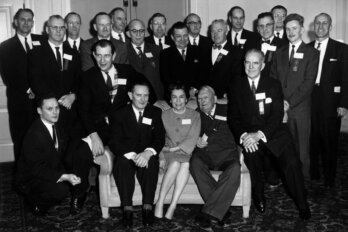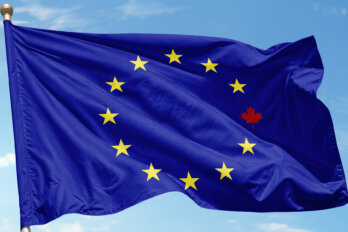The Arctic is the sort of place that warms Vladimir Putin’s heart. The Russian president sees the high north’s icy harshness as one of his country’s greatest strengths, a vision he inherited from a long line of authoritarian rulers, running through Soviet dictator Joseph Stalin all the way back to the imperial czars. Unforgiving and yet endowed with abundant natural gifts to be exploited, the Arctic is the perfect backdrop for the image Putin loves to project: a leader who rallies patriots to conquer a cruel frontier and promises untold riches.
But these riches are only for those with the unrelenting strength to seize them—even if the stirring enterprise is really a black hole for massive state subsidies that help fuel the corruption choking Russia’s economy. After nineteen years in power, with four years as prime minister, the widely popular president has kept millions of Russians mired in poverty to benefit himself and his cronies, Progress Party leader Alexei Navalny told CNN. “The Putin regime is built on corruption,” charged Navalny, who was banned from the March 2018 elections. “According to official data, over 20 percent of our population lives below the poverty line. And people link the obvious. Why are we so poor? Because they steal so much.” The next day, Russian police manhandled Navalny at a Moscow rally—one of about 100 cities across the country calling for an election boycott—and hauled him off to a cell.
Navalny was seen as a minor irritant to a seemingly unstoppable autocrat frequently likened to a modern czar—and, as a dissident, he could have ended up in a frozen labour camp. For centuries, the Russian Arctic and remote Siberia have been notorious places of punishment, where perceived enemies of the state were banished as criminals to work the mines and build the cities that expanded the state’s power. Under Putin, the lands of exile and their resources now enrich some of Russia’s most crooked business people, magnates who help the president maintain his grip.
In an apparent bid to name and shame those Russians central to Putin’s power base, and to potentially target them for new sanctions, in January 2018, the US Department of the Treasury created a list that included ninety-six oligarchs. Months later, they handed out sanctions. Among the accusations levelled by the administration were “supplying [Syria’s] Assad regime with material and weaponry as they bomb their own civilians, attempting to subvert Western democracies, and malicious cyber activities,” according to the press release. “Russian oligarchs and elites who profit from this corrupt system will no longer be insulated from the consequences of their government’s destabilizing activities.”
The press release named seven Russian tycoons, a dozen companies they control, and seventeen senior Russian government officials. The targets, including some of Putin’s closest allies, were barred from doing business with major Western firms and from travelling to the US. “The Russian government operates for the disproportionate benefit of oligarchs and government elites,” Treasury secretary Steven Mnuchin said. All but two of the seven industrialists named are specifically cited “for operating in the energy sector.” Increasingly, that is a Far Northern enterprise, as Russia taps deeper into its more remote fossil-fuel resources.
The Treasury’s sanction list includes Putin’s former son-in-law, Kirill Shamalov, who became a billionaire within months of marrying the president’s purported daughter Katerina Tikhonova, in February 2013. Extremely lucrative transactions with energy giants quickly followed, according to the US Treasury. Besides being active in energy projects, resource baron Oleg Deripaska drew the Treasury’s ire for suspected money laundering and, according to a 2018 press release from the department, has been accused of “threatening the lives of business rivals, illegally wiretapping a government official, and taking part in extortion and racketeering. There are also allegations that Deripaska bribed a government official, ordered the murder of a businessman, and had links to a Russian organized crime group.” Fighting to clear his name, he filed a lawsuit against the Treasury in March, accusing the department of “weaponizing the financial system against him,” according to a CNBC article.
“Deripaska has said that he does not separate himself from the Russian state,” the Treasury stated in announcing sanctions a year earlier. The same could be said of many among Russia’s richest, whose spectacular wealth depends on Putin’s good favour. Others who have fallen afoul of the president have ended up in prison, forced into exile, or, in the case of one-time billionaire Boris Berezovsky, dead.
Murmansk, the Russian Arctic’s biggest city, has a dark past and an uneasy future. I came to this coal-dusted port to see how Putin’s narrative of Russia’s northern destiny held up against a lethally cold reality. I found a northern nexus, where converging tracks of power, corruption, and promise connect with a time-worn facet of the Russian soul that has long perplexed outsiders: obedience to authority born of a fear that instability would bring much worse.
Some of the largest beneficiaries of Putin’s northern strategy include carbon-fuel tycoons like Vagit Alekperov, chief executive officer of Lukoil, Russia’s largest oil company not directly run by the state. He started at the bottom, working on oil rigs in the Caspian Sea, and climbed the ladder to become deputy minister in the Soviet Union’s oil ministry in 1990.
Then there’s Gennady Timchenko, co-owner of natural-gas giant Novatek. He is also worth north of $22 billion (all figures US), according to Forbes. Putin’s costly Arctic development push helps buy support from oligarchs like Alekperov and Timchenko with tax breaks that soften the extraordinary price of making money in one of the most forbidding environments on earth.
Just outside Murmansk, Alekperov’s Lukoil has anchored a floating export hub for its growing Arctic oil business. The Kola, a tanker with room for 309,000 tons of crude, supplies smaller vessels bound for foreign ports. The oil is shipped in from a coastal terminal on the Pechora Sea that handled 7 million tons of crude in 2017.
On the western side of Murmansk’s Kola Bay, a giant shipbuilding yard is rising to build platforms for Timchenko’s Novatek to extract natural gas and to build equipment for another plant to liquefy it. The liquid natural gas will then head across the Arctic through the upgraded northern sea route to international markets.
Another paragon of Russian commerce on the Treasury’s 2018 oligarch list is Andrey Melnichenko, one of Russia’s richest men as the owner of SUEK, the Siberian Coal Energy Company. It is, according to estimates, the largest exporter at the Murmansk port. Forbes puts the net worth of Melnichenko, who started out in the early post-Soviet years running currency-exchange booths, at $13.8 billion. He is also a majority owner of EuroChem, which, in late 2016, sold its stake in Murmansk Commercial Seaport to Melnichenko’s SUEK, raising that giant’s controlling share to just over 75 percent. That made it easier for EuroChem to export iron ore and apatite, a fertilizer, from its nearby plant and gave the oligarch fresh revenue from transporting his minerals to foreign buyers.
Before the Soviet Union collapsed, Murmansk and the surrounding region were home to more than 1 million people. Many fled at the earliest opportunity, leaving some 700,000 residents carving a living out of the permafrost, toiling through forty days of polar night each winter, slogging through snow and ice, 257 kilometres above the Arctic Circle.
On the city’s northern edge is Kola Bay, a long, slender fjord close to 1,600 kilometres north of Moscow. It’s home port to the next generation of the world’s biggest and most advanced fleet of nuclear-powered icebreakers. They share the Barents Sea with the Russian navy’s northern fleet, which Putin is modernizing to pressure NATO’s “northern flank.”
Kola Bay’s eastern shore is cloaked in a perpetual grey industrial haze, churned out by rows of giant yellow cranes in the Murmansk Commercial Seaport that dwarf hard-hatted stevedores who look like insects skittering around heaps of shattered black rock. In 2016, those cranes moved some 14 million tons of coal that roll in on endless streams of freight trains, a dirty carbon export that accounts for more than 90 percent of the volume shipped from the Murmansk port. Other cargo includes crude oil, fertilizer, and iron ore.
Murmansk’s tallest building, the Azimut Hotel Murmansk, is also the Arctic’s highest. Since 1984, it has towered nineteen floors above the heart of the city, where the modern Murmansk Mall, with its designer shops and busy food court, meets the coal dust wafting from the railyards. Just across the tracks, newlyweds pose for wedding photos in front of the Lenin, the world’s first nuclear-powered icebreaker, anchored in Arctic waters as a museum.
Putin’s vision of restoring Russia to the status of a global power and the tight web of business and political allies that form the scaffolding of his regime are directly tied to the country’s Arctic dominance. Putin is determined to take an already formidable lead in the Far North, staking his nation’s future wealth on exploiting the resources of a warming Arctic. And, based on now well-established rules of the Putin Great Game, the president and his cronies also stand to take a significant cut for themselves. A potential bonanza awaits in the surrounding region of vast, deep-sea mountain ranges, an area covering several hundred thousand square kilometres rich in oil, natural gas, and other lucrative resources.
Russia’s territorial claim was made to the UN in 2015. Canada has signalled it has a conflicting claim. When international law and diplomacy clash with raw power, the latter frequently wins out. Putin has repeatedly said Russia wants peace in the Arctic—calling it “a region for peace and co-operation”—and long-standing cooperation among Arctic nations, including the US and Russia, has survived tensions elsewhere. But the Russian president has shown his willingness to use force in Georgia and Crimea, and some of the small Arctic nations fear they may be next. Since 2017, about 300 US Marines have been stationed in Norway, the first time since the Second World War that Norwegians have invited foreign forces to set up posts in their oil-rich country. “I hope I’m wrong, but there’s a war coming,” then Marine Commandant General Robert Neller told the Americans sent to help deter Russia from designs on Norway in late 2017. “You’re in a fight here, an informational fight, a political fight, by your presence.”
Early in 2018, China made its Arctic shipping ambitions official policy by calling for a “polar silk road” linking China to Europe, with an eye on the Northwest Passage that Canada considers an internal waterway. The US is among a number of countries that see the passage as an international strait, open to any who want to transit. China’s view is less clear, and as it expands its influence in the Arctic, some experts see signs it might side with the US on the right of passage.
Meanwhile, Putin is building up military and civilian infrastructure along the more developed northern sea route, an easier passage for large ships, because it hugs the Arctic coastline of Russia, which hopes to profit handsomely from fees. This shorter global shipping route that expands Russia’s strategic influence along with foreign markets is a huge state-funded benefit to the Putin oligarchy. Yet it perpetuates the age-old authoritarian streak, a constant drain on economic innovation and social progress in Russia, just like the corrupt oligarch system from which Putin profits.
That wealth watchers would even track the net worth of a former KGB colonel and judo champion with a law degree says a lot. But oft-quoted Russian estimates are mind boggling. Putin’s precise net worth is shrouded in secrecy. Those who have tried to track his expanding assets suggest he has amassed a fortune of anywhere from $40 billion to $70 billion, perhaps much higher, with an obscene hoard of luxuries, including reports of a palace on the Black Sea, several yachts, and enough aircraft to form his own squadron.
Whether Russia can break the bonds of old habits and complete the transition from state-run Soviet enterprise to crony capitalism—and then a modern economy that rewards innovation over political connections—depends in part on people like Andrei Rappoport.
Rappoport learned the ropes as a top executive for two other billionaires, Alfa Bank owner Mikhail Fridman and exiled oil oligarch Mikhail Khodorkovsky, and built a net worth of $1.11 billion, according to Forbes. Now another prominent face in the US Treasury’s rogues gallery, Rappoport is tasked with training future generations of potential tycoons as a founding member of Skolkovo Innovation Center’s Moscow School of Management, the centrepiece of what was supposed to be Russia’s Silicon Valley.
In 2009, when the world was still reeling from the worst financial crisis since the Great Depression, then president Dmitry Medvedev raised Russian hopes by committing $4 billion to transform 243 hectares of muddy farmland outside Moscow into the gateway to a new economy. (Medvedev had been elected in 2008, while Putin served as prime minister.) In theory, the government effort would help to wean Russia off its dependence on fossil-fuel exports and mining companies that help feed top-level corruption and to give high-tech entrepreneurs a leg up. Some of the biggest names in international business, such as Boeing, General Electric, IBM, and Samsung, signed on as “strategic partners.” The prestigious Massachusetts Institute of Technology, home to at least thirty-six graduates who have won the Nobel Prize, established a partnership with the Skolkovo Institute of Science and Technology.
Skeptics abounded. Putin, they argued, had handed the presidency to Medvedev only because the constitution limited the president to two consecutive terms. As prime minister, Putin was the real power, waiting to resume the official top spot, undermining Medvedev’s proreform agenda. Believers pointed out that US government money seeded Silicon Valley long before brash young geeks became instant millionaires there. But Medvedev’s pet project reminded many Russians of rusting, Soviet-era “science cities,” known as naukograds, which often relied on forced labour from political prisons.
When I visited in 2011, Skolkovo was still mostly a dream. Architects’ drawings showed a shining city of 30,000 people, with abundant green space, a network of paths for bicycles tracked by computer, and streets open only to electric vehicles. Although farmers’ fields have given way some impressive architecture, the city is today still a long way from fulfilling its designers’ idyllic vision.
Alexander Turkot, executive director of information technology, greeted me in jeans, a black shirt, and a yellow polo sweater. With his sleeves rolled to the elbows, he had the smart-casual ease of a Western tech guru. “I would like to show these young talents, potential hackers and criminals, that, guys, you can make money and be successful—socially too—not only by committing crime or having your dad or uncle working for a gas-oil company,” Turkot told me. “Do it with your brains. Engineer is a good definition to make progress in your life.”
Less than two years later, the high-tech promise of Skolkovo was tainted by scandal.
Investigators following a whiff of graft wanted to know why the business school paid tech entrepreneur Ilya Ponomaryov, who was also a prominent Putin opponent in the Russian parliament, $750,000 of the public’s money for ten lectures and a research paper. They could only find evidence that he gave two lectures, totalling half an hour, state-run RT News reported in May 2013.
“The charges were trumped up, in a fashion typical for modern Russia,” Ponomaryov later wrote from exile in a New York Times op-ed. “My real crime: I was the lone dissenter, in March 2014, when the Duma voted, 445 to 1, to approve the annexation of Crimea. My vote made headlines across the West, where my distaste for President Vladimir V. Putin is well known.”
Skolkovo’s troubles were compounded after anticorruption agents raided it in 2013. This was followed by a government order to cut costs by 20 to 40 percent and a steady exodus of tech experts, the journal Foreign Policy reported the following year. Despite its early troubles, the Skolkovo Innovation Center still has a global list of big-name partners. While some initial investors pulled out, fresh ones are putting more money in. MIT is still a big supporter, holding its biggest Skoltech—the US university’s joint conference with Skolkovo—in the spring of 2017. “One of the aims of creating Skoltech was to create an environment for entrepreneurial talent in our country,” university president Alexander Kuleshov told the gathering, which included several MIT professors born in Russia. “In the long haul, we’d like to create the conditions and environment to allow our young talents to stay here in Russia, to realize their professional potential here.”
But Putin’s well-heeled enemies aren’t the only ones fleeing their homeland. A younger generation of frustrated innovators are following—if they can afford Western universities or land plum jobs abroad—risking a prolonged brain drain that would only weaken the hand of reformers. It is an epic battle between resource extraction and tech, with corruption as a heavy weapon, and hopes for a new Russia hang in the balance.






